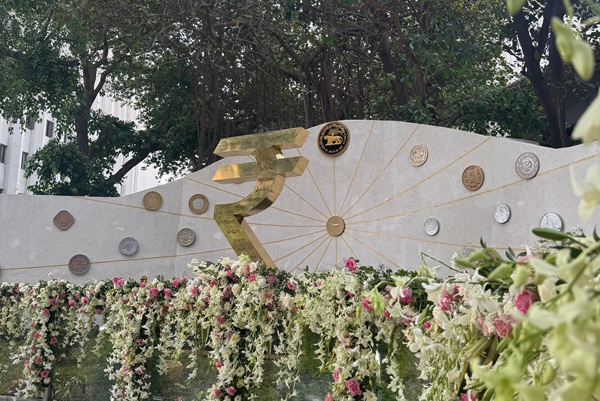.png)
Rupee’s Strategic Faultline-SWOT analysis
The rupee’s fate will hinge less on daily volatility and more on how India tackles its oil dependence, export narrowness, and dollar reliance.


Babuji K is a career central banker with 35 years at RBI in exchange rate management, reserve operations, supervision, and training.
October 3, 2025 at 10:19 AM IST
The rupee’s weakness is not a trading story but a structural one. Its future will be shaped by how India reduces its oil dependence, broadens exports, and lessens reliance on the dollar.
Strengths
India’s economy is cushioned by the sheer scale of its domestic demand. Consumption makes up 61% of GDP, far higher than the 21% contributed by exports. This gives the country some insulation from the vagaries of global demand cycles. Foreign exchange reserves of about $700 billion, covering nearly a year of imports, provide a buffer against sudden shocks.
Technology services exports of more than $200 billion a year are a pillar of resilience, while the pharmaceutical industry supplies one fifth of the world’s generic medicines.
New sectors are emerging as well. The generative AI startup ecosystem expanded from 66 firms in early 2023 to over 240 by mid-2024. These strengths underpin confidence in India’s long-term potential and provide the scaffolding on which a stronger rupee can be built.
Recent policy initiatives announced by RBI further strengthens the resolve of the central bank for a push towards internationalisation of rupee. The policy inter alia, seeks to enable regional lending in rupee, establish currency reference rates for currencies of India’s major trading partners to facilitate smoother rupee settlements, and expand investment options by using balances in Special Rupee Vostro Accounts with an objective to further reduce dollar dependency.
Weaknesses
The 2022 oil price spike following Russia’s invasion of Ukraine showed how quickly the rupee can be undermined. India’s oil import bill almost doubled in a year, reserves dropped by $20 billion in four months, and the currency weakened by 2.5%. Reliance on oil not only drains foreign exchange but also conflicts with climate goals of net zero by 2070 and 50% non-fossil power capacity by 2030.
Exports are narrowly based, concentrated in technology services and pharmaceuticals. This leaves India vulnerable to regulatory or policy shocks in key markets such as the United States. Manufacturing exports have yet to achieve scale, and diversification is limited. Dollar dependence further compounds the weakness. Limited capital account convertibility and shallow forex markets restrict the rupee’s international use, keeping India tethered to global dollar cycles.
Opportunities
Expanding solar and wind generation, paired with storage solutions, can displace diesel-based backup power. Biofuels can cut crude imports while boosting rural incomes. The vehicle scrappage policy that mandates testing of private vehicles older than 15 years from mid-2025 will modernise the fleet and reduce emissions.
Diversifying exports is equally urgent. Beyond IT and pharma, India can expand into biosimilars, medical devices, and advanced manufacturing. Off-shoring strategies, Global Capability Centres, and greater R&D investment can help businesses adapt to shifting geopolitics.
The trade agreement with the European Free Trade Association, effective as of September 2025, presents new opportunities for textiles, leather, and processed food.
Tourism is an underused source of stable foreign exchange. With cultural heritage spanning millennia, India could leverage spiritual tourism, heritage circuits, and wellness traditions to build a steady stream of earnings that are less volatile than capital flows.
Financial resilience can be bolstered through hedging. Refiners are already permitted to hedge oil imports, and wider use of such tools by end-users of petroleum derivatives could smooth currency impacts. Rupee settlement agreements with Russia, Sri Lanka, and the UAE mark an early step toward internationalisation, reducing dollar exposure and transaction costs.
Threats
The rupee’s limited global role means that any attempt to internationalise will be slow and fraught. Without deeper forex markets and greater convertibility, the currency will remain vulnerable to swings in global liquidity conditions and investor sentiment.
One of the often-overlooked aspects is the threat relating to exchange rate of our competitors. If our currency rate is not competitive with our peers we would get priced out in the international trade and hence whether we like it or not, would have to allow depreciation of the currency.
Similarly, the interest rate differential also plays an important part in determination of exchange rate, and the country would attract more inflows only if this metric is advantageous to international players.
Another related concept is the “impossible trinity” (also called the trilemma or Mundell-Fleming trilemma) which postulates that a country which does not have a completely floating exchange rate regime may be required to sacrifice one of the three states, a Fixed exchange rate - Maintaining a stable currency value against other currencies Free capital flow - Allowing unrestricted movement of capital across borders Independent monetary policy - Setting domestic interest rates to manage the economy. India which has a kind of “managed float” regime attempts to balance the above three, prioritises them according to domestic economic and financial stability.
Path forward
Energy policy must move decisively towards renewables and electric mobility. Industrial strategy must lift manufacturing exports and encourage innovation beyond established sectors. Financial markets must deepen to allow hedging and encourage confidence in rupee assets.
The story of the rupee is in many ways the story of India’s economic transformation. It has undeniable strengths in consumption, reserves, and technology. It has weaknesses in oil dependence and narrow exports. It has opportunities in clean energy, manufacturing, and tourism. It faces threats from oil shocks, trade conflicts, and climate volatility. Whether it emerges as a resilient currency will depend on how these forces are managed. The rupee’s future will not be decided in trading rooms but in the broader reform agenda that ties together economic security and environmental sustainability.
BasisPoint Briefing — Explainers from seasoned practitioners for readers who want more than the basics.



